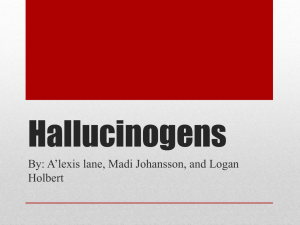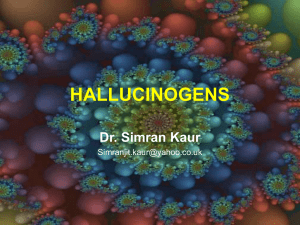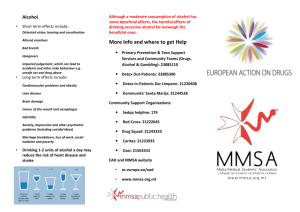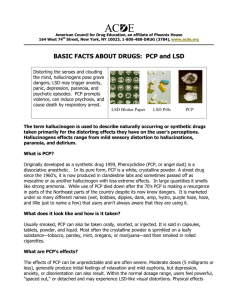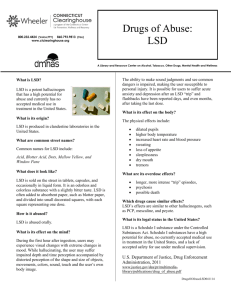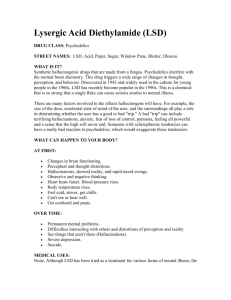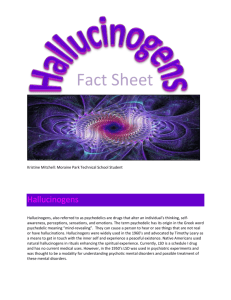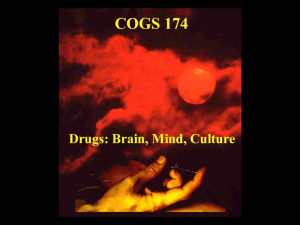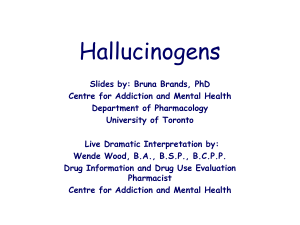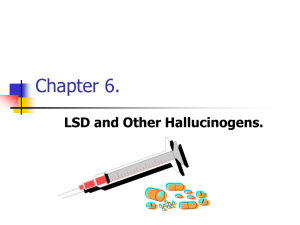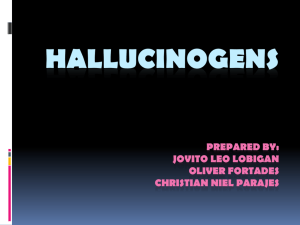Phencyclidine Street names
advertisement
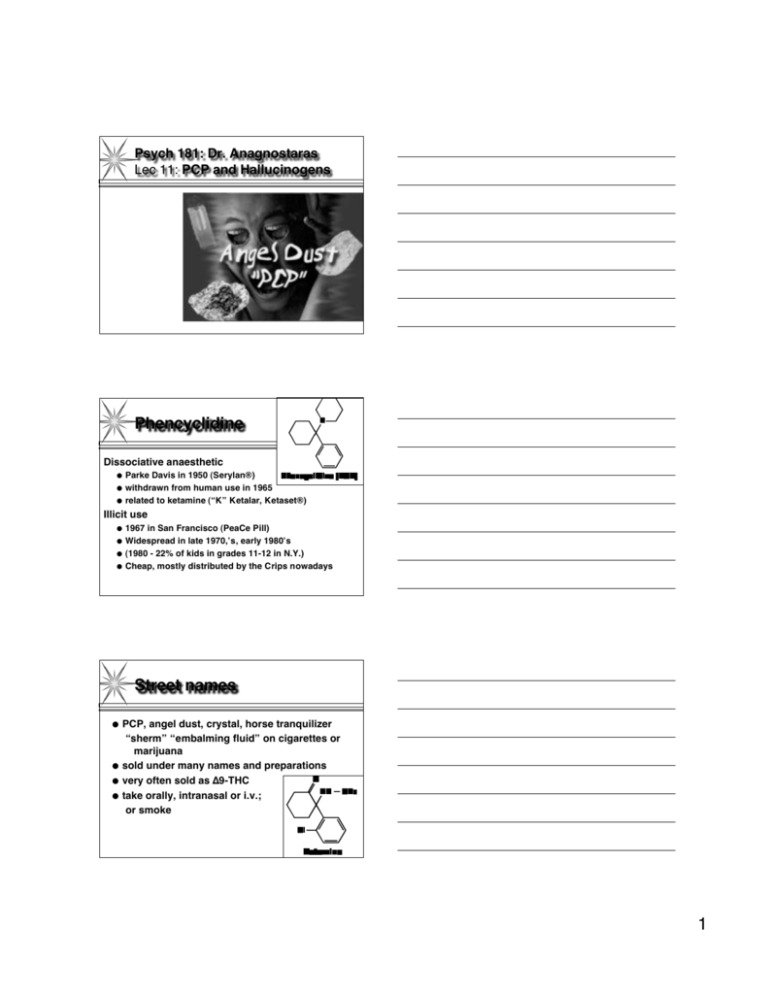
Psych 181: Dr. Anagnostaras Lec 11: PCP and Hallucinogens Phencyclidine Dissociative anaesthetic Parke Davis in 1950 (Serylan®) withdrawn from human use in 1965 related to ketamine (“K” Ketalar, Ketaset®) Illicit use 1967 in San Francisco (PeaCe Pill) Widespread in late 1970,’s, early 1980’s (1980 - 22% of kids in grades 11-12 in N.Y.) Cheap, mostly distributed by the Crips nowadays Street names PCP, angel dust, crystal, horse tranquilizer “sherm” “embalming fluid” on cigarettes or marijuana sold under many names and preparations very often sold as ∆9-THC take orally, intranasal or i.v.; or smoke 1 Effects Low dose (1-5 mg) alcohol-like effect (giddy drunken-like state, disinhibition) Moderate dose (5-10 mg) distortion of space & time, psychotic reactions (panic, agitation, depression, catatonia, paranoia) “anaesthetic” and analgesic effects blank stare, amnesia, mutism Toxic psychosis High dose (> 10 mg) model of acute schizophrenia, including true hallucinations (can last up to 1-7 days with high doses) sometimes violent, abusive behavior Overdose Respiratory depression/seizures Self-administration Reinforcing effects Readily self-administered in animals point of intoxication modest tolerance addiction and withdrawal to 2 Mechanisms of action Two distinct binding sites Sigma site - generalizes with benzomorphans PCP site (“PCP receptor”) PCP site part of the NMDA glutamate receptor Glutamate (glutamic acid) Ubiqutious excitatory transmitter Depolarizes virtually all cells Primary transmitter for fast excitatory signalling Glutamate receptors Ionotropic subtypes Non-NDMA Types AMPA Kainate NMDA Selectively binds N-Methyl-D-aspartate Metabotropic subtypes 3 Glutamate receptors 10.2 PCP/NMDA interactions Noncompetative antagonist at NMDA receptor site inside channel - blocks it not antagonize AMPA/kainate effects 10.10 Other actions Effects on many transmitter systems Action at sigma site Enhances DA release Locomotor activity 17.20 4 Neuropathology Multiple vacuoles form in cytoplasm of some neurons and mitochondria disappear 2-4 hrs after treatment Increasingly obvious 4-12 hrs after drug Disappear within 24 hrs Only certain parts of cortex Related to acute toxic psychosis? Neuropathology Eight day old rats treated once with PCP or MK801 and brains examined 24 hours later. + _ Sustained activation of NMDA receptors at critical stages in development activates programed cell death. See with PCP, ketamine (special K) and ethanol 5 Control Drug Degenerating neurons PCP Excitotoxicity Glutamate excitotoxicity MK-801 10.14 Hallucinogens Common features Hallucinogen the ability to evoke hallucinations pseudohallucinations; illusions Psychotomimetic ability to mimic endogenous psychosis Phantasicum, Psychedelic “mind-expanding” change in perception of reality 6 Major classes The LSD ‘Family’ indole type hallucinogens similarity to 5-HT (serotonin) LSD (lysergic acid diethylamide) structural Major classes The Phenylethylamines structural similarity to CA’s hallucinogenic and stimulant effects mescaline mixed LSD type hallucinogens LSD (lysergic acid diethylamide) acid, blotters, windowpane, etc. 7 LSD type hallucinogens LSD (lysergic acid diethylamide, LSD-25) Hofman (1938) • led to Imitrex& Zomig LSD type hallucinogens LSD (lysergic acid diethylamide) ergot LSD Absorption and metabolism Tolerance 8 LSD type hallucinogens Psilocybin and Psilocin magic mushroom genus Psilocybe LSD type hallucinogens DMT (Dimethyltryptamine) naturally-occuring LSD-like substance in plants; e.g. Piptadina peregrina (bean plant) Morning Glory Seeds lysergic acid amide (LSA) Bufotenin (5-hydroxy-DMT) Harmine and Harmaline The phenylethylamines structural similarity to CA’s hallucinogenic and stimulant effects mescaline mixed 9 Mescaline in peyote cactus (Lophophora Williamsii) button mescal The phenylethylamines Methoxyamphetamines synthetic many derivatives of mescaline are so-called “designer drugs” Methoxyamphetamines DOM (dimethoxymethylamphetamine) Called STP often TMA (trimethoxyamphetamine) Similar to mescaline, but more potent MDA and MDMA Methylenedioxyamphetamine and methylenedioxymethamphetamine 10 Major effects (LSD) Sensory-Perceptual pseudohallucinations illusions synesthesias, etc. Psychic Experiences Somatic Effects Adverse effects Bad ‘trips’ Flashbacks Mechanisms of action Common action for hallucinogenic effects sensory-perceptual effects and psychedelic effects Only short-term tolerance to LSD, no withdrawal, dependence or addiction LSD not lethal at very high doses Cross tolerance for hallucinogenic effect Focus on 5-HT systems (structural similarity) 11 Serotonin (5-hydroxytryptamine) Receptors 5-HT 1, 2….. Synthesis & storage (14 subtypes Known) Inactivation & degradation Raphe 9.1 Mechanisms of action • Initial prevailing view from peripheral tissues - block action of 5-HT (antagonist?) • Second view: agonist at inhibitory autoreceptors • increases 5HT content and 5HIAA down turnover down? • inhibits firing of 5HT neurons • discredited by presynaptic lesion studies Current Postsynaptic hypothesis Binding to 5-HT receptors (over 14 subtypes) LSD is fairly promiscuous (5-HT1/2/5/6/7 types) Mescaline not to 5-HT1/5/7 All have affinity for 5-HT2 family 5-HT2A shows greatest expression in neocortex Hypothesis: LSD and other hallucinogens are 5-HT2A postsynaptic receptor agonists 12
